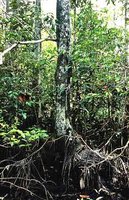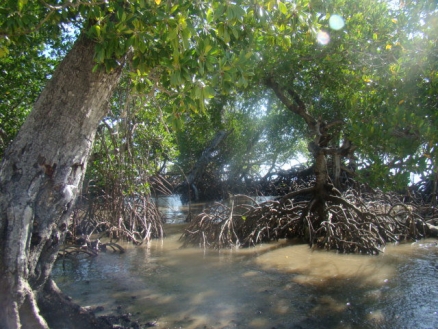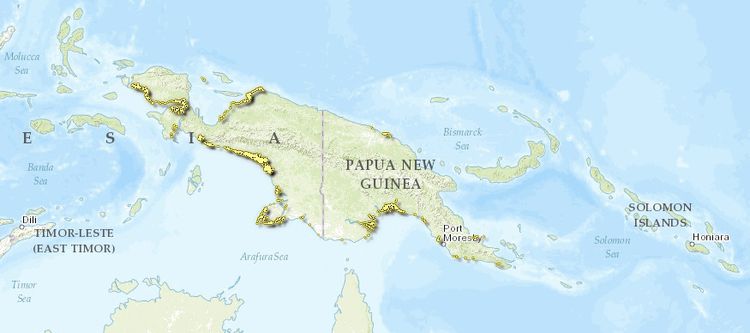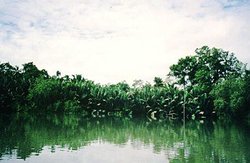New Guinea mangroves
Introduction A dynamic and essential vegetation type at the interface of terrestrial and marine environments, New Guinea's mangroves (New Guinea mangroves) are among the most diverse (Species diversity) in the world. In some areas, monodominant stands of 1-meter (m) diameter Xylocarpus granatum resemble North American bald-cypress swamps.
Location and General Description
New Guinea mangroves are found along extensive lengths of its coastline. There are several disjunct sections along the north coast, including the eastern side of Cenderwasih Bay, adjacent to the mouths of the Sepik and Ramu rivers, and Dyke Ackland Bay and Ward Hunt Strait. The longest and deepest stretches of mangroves are found on the south side of the island, especially at the mouths of the Purari, Kikori, Fly, Northwest, and Otakwa Rivers, Bintuni Bay, and the southern portions of the Vogelkop Peninsula. With the exception of the coast along the Trans Fly region of southern New Guinea, the climate of the ecoregion is tropical wet, which is characteristic of this part of Melanesia, located in the western Pacific Ocean north of Australia. The surface geology of this widespread, dynamic ecoregion consists of alluvium on active alluvial plains and fans.
Located in the Indo-Malayan center of diversity, southern Papua New Guinea (PNG) has the highest diversity (Species diversity) of mangroves in the world. In the dynamic tidal environment of the delta, a general succession process occurs through time and space. The pioneering species that establish on sheltered coastal shores are Avicennia alba or Avicennia marina. On tidal creeks, Sonneratia species are the first to establish. The complex root network of these species encourages further sedimentation in the immediate area. As the land surface continues to rise relative to water levels, Rhizophora mucronata invades, overshadows the shade-intolerant Avicennia and Sonneratia species, and takes over. Rhizophora apiculata and Bruguiera parviflora are the next colonists, with occasional Bruguiera gymnorrhiza. B. gymnorrhiza develops into dominant stands away from the water. Xylocarpus, Lunmitzera, and Heritiera also establish late in succession.
Within this simplified successional picture there are more subtle patterns. Mangrove areas transitional between upland or coastal environments contain the greatest variety of species, growth forms, and forest structures. Where there is substantial freshwater influence within the mangrove, stands of Nypa fruticans develop. Mangrove areas adjacent to swamp forest contain Bruguiera sexangula, Camptostemon schultzii, Dolichandrone spathacea, Diospyros spp., Excoecaria agallocha, Heritiera littoralis, Rhizophora apiculata, and Xylocarpus granatum. However, typical swamp forest trees such as Calophyllum, Instia bijuga, Myristica hollrungii, and Amoora cucullata are also part of the mix in transitional areas. The upper limit of Sonneratia lanceolata is taken to be the boundary between brackish and freshwater (Freshwater biomes) reaches of the Purari delta.
Mangrove vegetation is sensitive to soil and water salinity, drainage, and inundation period. Because of a larger tidal influence (resulting from smaller freshwater flows), some areas, such as the Kikori delta, have a more extensive mangrove coverage than others.
A simpler description of zonation of the nearby Fly River mangroves is given by Robertson et al. In this zonation there are three zones as one moves inland: a Sonneratia-Avicennia zone on actively accreting shores, a Rhizophora-Bruguiera zone where salinities generally are greater than 10 percent (subdominant species include B. gymnorrhiza, Avicennia marina, Ceriops decandro, and Heritiera littoralis), and a Nypa zone. Nypa fruticans may form vast monotypic stands, but the Nypa zone also includes Xylocarpus granatum and Heritiera littoralis. Salinities in this zone generally are between 1 and 10 percent.
Biodiversity Features
Mangroves provide a keystone habitat that provides for vital ecological functions in the terrestrial-marine interface. They accumulate sediment, stabilizing and protecting the coastline from erosion, and provide a buffering exchange of nutrients between the terrestrial and marine environments. Mangroves also provide a nursery for many coastal fishes.
Table 1. Endemic and Near-Endemic Mammal Species. Family Species Emballonuridae Emballonura furax An asterisk signifies that the species' range is limited to this ecoregion. Generally, this ecoregion (New Guinea mangroves) exhibits low richness and endemism when compared with other ecoregions in Indo-Malaysia. Exact species lists are difficult to derive for mangroves because of the transitional nature of the habitat. Some species are clear inhabitants of mangroves. The ecoregion harbors one near-endemic mammal species: New Guinea sheathtail bat, Emballonura furax (Table 1). {| border="1" cellpadding="3" align="left" ! colspan="3" align="center" | Table 2. Endemic and Near-Endemic Bird Species. Family Common Name Species Megapodiidae Red-billed brush-turkey Talegalla cuvieri Columbidae Wallace's fruit-dove Ptilinopus wallacii Columbidae Western crowned-pigeon Goura cristata Psittacidae Salvadori's fig-parrot Psittaculirostris salvadorii Loriidae Black lory Chalcopsitta atra Loriidae Brown lory Chalcopsitta duivenbodei Apodidae Papuan swiftlet Aerodramus papuensis Alcedinidae Red-breasted paradise-kingfisher Tanysiptera nympha Pachycephalida White-bellied pitohui Pitohui incertus Dicaeidae Olive-crowned flowerpecker Dicaeum pectorale An asterisk signifies that the species' range is limited to this ecoregion. Mangroves are only a component of the several Endemic Bird Areas (EBAs) identified by Birdlife International. New Guinea mangroves (New Guinea mangroves) contain ten endemic or near-endemic bird species (Table 2). The key ecological process in mangrove areas is disturbance related to the dynamism of the geology and geomorphology of the coastal and delta systems on which the mangroves are built. The regeneration of various tree species is closely tied to subtle changes in elevation, drainage, and inundation periods, which are in turn the result of larger-scale geomorphologic processes. Delta development is controlled by the geologic environment, sea-level change, tectonics, fluvial contributions, climate, vegetation, and the receiving basin. Although New Guinea's tropical evergreen forests may appear unbroken and stable, closer inspection reveals widespread past episodes of periodic large-scale natural disturbance, including extreme wind events and El Niño-mediated drought-associated fires. River meandering is a major force in coastal mangrove areas. Lightning strikes are common in New Guinea, and analysis of lightning strikes in the mangroves of PNG's Gulf Province indicates that gaps from lightning strikes affect the entire forest for about a 200- to 300-year period. In a plot established in a 50-m-diameter lightning strike patch in mangroves near Labu (Central Province), all canopy trees were killed. Lightning is thought to kill trees by traveling through the ground via root grafts, disrupting membrane structure and salt uptake abilities. A dense ground flora subsequently developed. The ground flora was dominated by 5- to 6-m-high Xylocarpus, with small patches of Acrostichum aureum and many Rhizophora apiculata seedlings. ==Current Status== {| border="1" cellpadding="3" align="right" ! colspan="3" align="center" | Table 3. WCMC Protected Areas That Overlap with the Ecoregion. Protected Area Area (km2) IUCN Category Teluk Bintuni 2,670 PRO Gunung Lorentz [AA0105], 127, 128, 131] 3,130 I Pulau Dolok [AA0121] 1,780 IV Kikori River [AA0121], [AA0122] 1,190 ? Total 8,770 Ecoregion numbers of protected areas that overlap with additional ecoregions are listed in brackets. Four protected areas in Indonesia (New Guinea mangroves) and PNG protect approximately 33 percent of the ecoregion (Table 3). Harvestable quantities of timber species are present in some of the larger mangrove areas, including Kwila (Instia bijuga, Fabaceae) and Papuan mahogany (Xylocarpus granatum, Meliaceae). Some woody species have been exploited to make charcoal for cooking in Indochina, including Rhizophora apiculata, R. mucronata, Avicennia marina, and Xylocarpus. ==Types and Severity of Threats==  Papua New Guinea. (Photograph by Don Henry) The mangroves are a difficult environment in which to work, and so far mostly small walkabout mills have been used in the mangroves to cut timber. Large-scale timber operations exist in Bintuni Bay, Irian Jaya. Estuarine crocodiles were heavily exploited, to the point of population collapse, in the mangroves of PNG's Gulf Province. ==Justification of Ecoregion Delineation== The mangroves along the coast of New Guinea were delineated as the New Guinea mangroves. We used the World Mangrove Atlas to determine the distribution and boundaries of mangroves. Udvardy placed these [[ecoregion]s] in the Papuan biogeographic province of the Oceanian Realm. ==Additional information on this ecoregion== * For a shorter summary of this entry, see the WWF WildWorld profile of this ecoregion. * To see the species that live in this ecoregion, including images and threat levels, see the WWF Wildfinder description of this ecoregion. * World Wildlife Fund Homepage Papua New Guinea. (Photograph by Don Henry) The mangroves are a difficult environment in which to work, and so far mostly small walkabout mills have been used in the mangroves to cut timber. Large-scale timber operations exist in Bintuni Bay, Irian Jaya. Estuarine crocodiles were heavily exploited, to the point of population collapse, in the mangroves of PNG's Gulf Province. ==Justification of Ecoregion Delineation== The mangroves along the coast of New Guinea were delineated as the New Guinea mangroves. We used the World Mangrove Atlas to determine the distribution and boundaries of mangroves. Udvardy placed these [[ecoregion]s] in the Papuan biogeographic province of the Oceanian Realm. ==Additional information on this ecoregion== * For a shorter summary of this entry, see the WWF WildWorld profile of this ecoregion. * To see the species that live in this ecoregion, including images and threat levels, see the WWF Wildfinder description of this ecoregion. * World Wildlife Fund Homepage |
|---|


